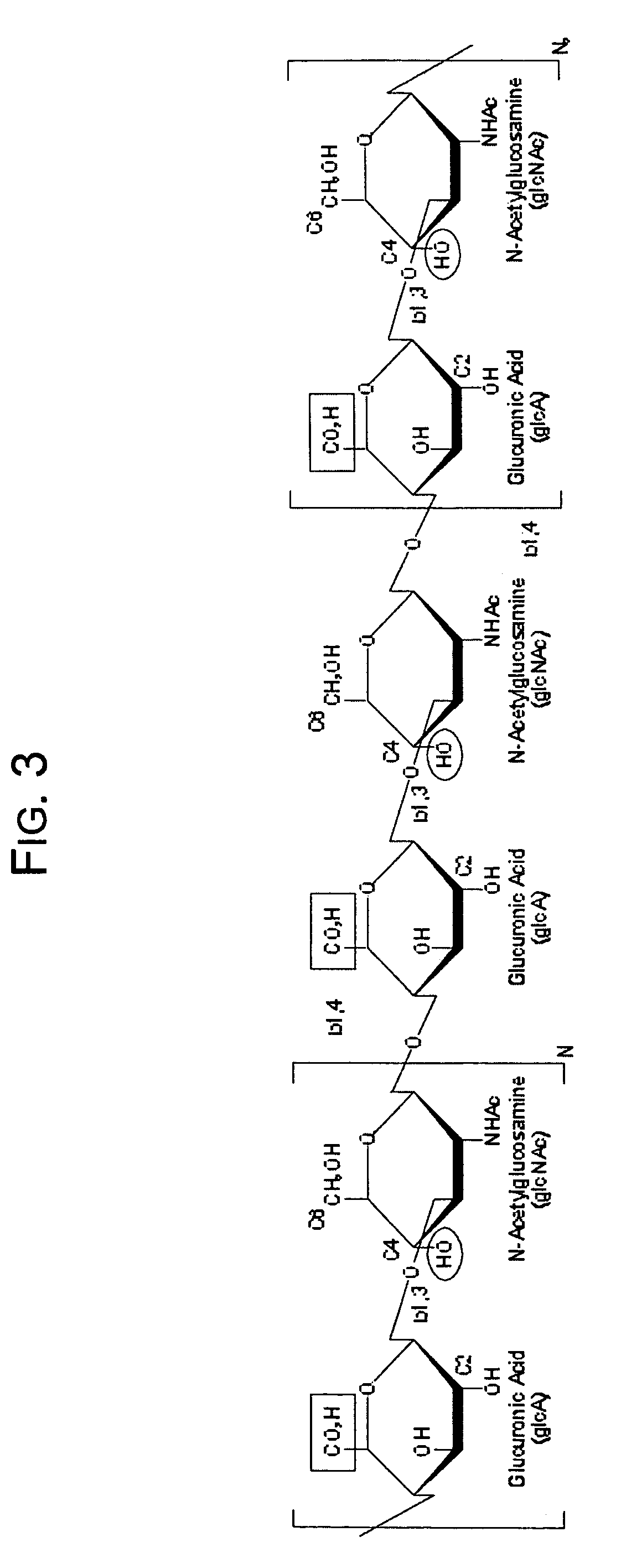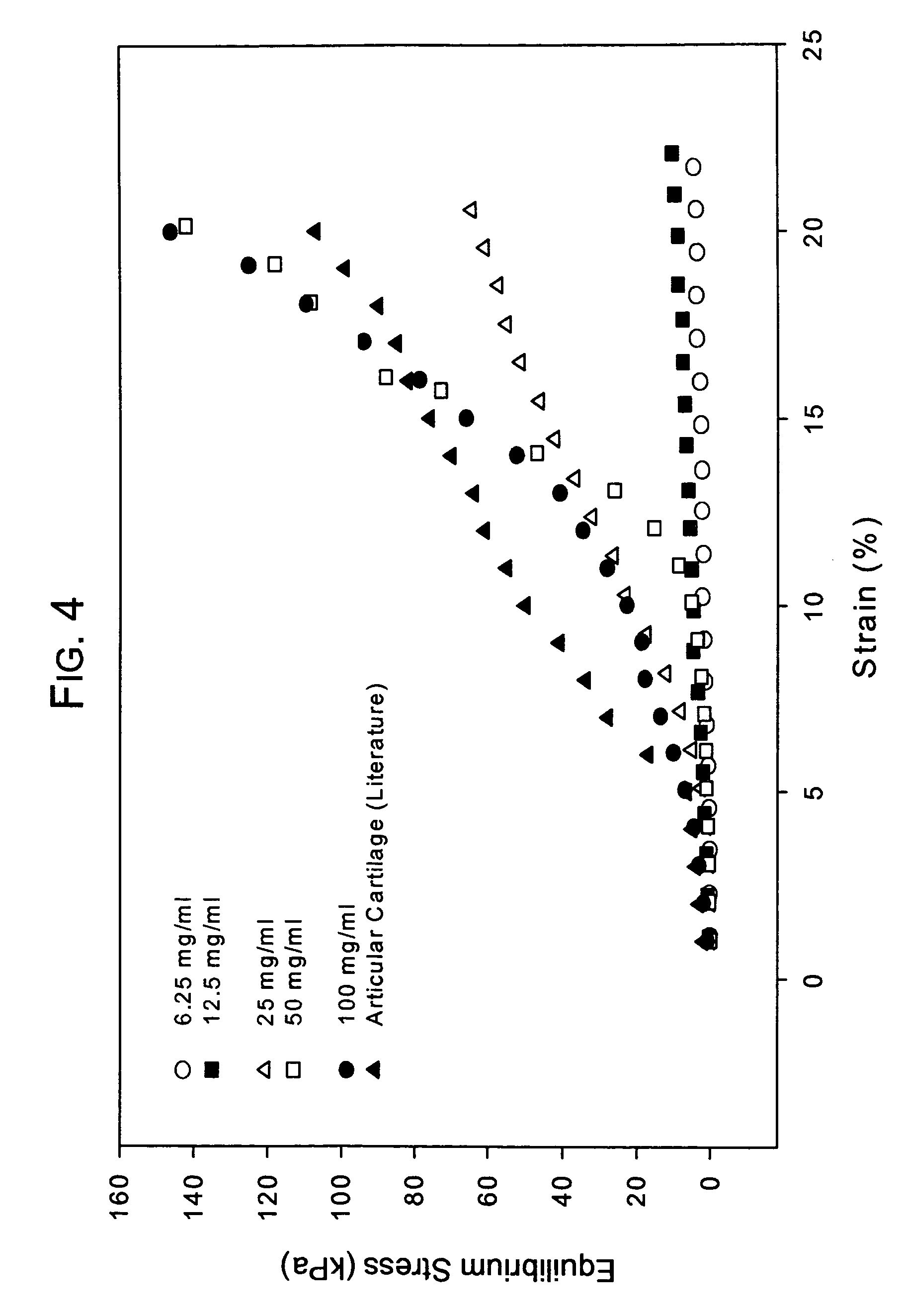Hydroxyphenyl cross-linked macromolecular network and applications thereof
a macromolecular network and cross-linked technology, applied in the field of hydroxyphenyl cross-linked macromolecular network and applications thereof, can solve the problems of insufficient duplicate arrangement via artificial or synthetic means in the prior art, no adequate remedy for cartilage degenerative disorders, and inability of fluid to negotiate the tight macromolecular network
- Summary
- Abstract
- Description
- Claims
- Application Information
AI Technical Summary
Benefits of technology
Problems solved by technology
Method used
Image
Examples
example 1
[0069]Experimental quantities of tyramine-substituted hyaluronan hydrogels having dityramine cross-links according to the invention have been prepared as follows. HA is dissolved at 1 mg / ml based on hexuronic acid in 250 mM 2-(N-morpholino)ethanesulfonic acid (MES), 150 mM NaCl, 75 mM NaOH, pH 6.5 containing a 10-fold molar excess of tyramine relative to the molar concentration of HA carboxyl groups. Tyramine substitution onto the carboxyl groups is then initiated by the addition of a 10-fold molar excess of EDC relative to the molar concentration of the HA carboxyl groups. A 1 / 10th molar ratio of N-hydroxysuccinimide (NHS) relative to the molar amount of EDC is added to the reactions to assist the EDC catalyzed amidation reaction by formation of active esters. Reactions are carried out at room temperature for 24 hours, after which the macromolecular fraction is recovered from unreacted small molecular weight reactants such as tyramine, EDC, NHS, and MES by exhaustive dialysis versu...
example 2
[0070]An experiment was conducted to determine the degree of tyramine substitution (and consequent dityramine cross-linking) for a T-HA macromolecular network according to the invention. Initially, three formulations of (uncrosslinked) tyramine-substituted hyaluronan (T-HA) were prepared as described above, designated 0×, 1× or 10×. The 0× formulation was prepared using no EDC (i.e. containing no carbodiimide), meaning there was no carbodiimide present to mediate the reaction for creating an amide bond between the NH2 group on tyramine and a CO2H group on the HA molecules. Thus, the 0× formulation can be considered a control. The 1× formulation contained a 1:1 stoichiometric ratio of EDC based on the quantity of CO2H groups present on the HA molecules in the reaction mixture. The 10× formulation contained a 10:1 stoichiometric ratio (or 10-fold excess) of EDC based on the quantity of CO2H groups present on the HA molecules in the reaction mixture. In all three formulations, a stoich...
example 3
[0076]Conventionally, it has been believed that natural cartilage exhibits its viscoelastic properties and its ability to resist deformation and absorb compressive loads principally as a result of the repulsive forces between negatively charged SO42− groups on adjacent chondroitin sulfate chains present in the aggrecan matrix. An experiment was performed to determine the efficacy of a macromolecular network according to the invention consisting only of dityramine cross-linked hyaluronan molecules (i.e. no aggrecan or chondroitin sulfate) to resist deformation and absorb compression compared to natural cartilage despite the absence of SO42− groups. A formulation of uncross-linked T-HA was prepared and purified as in Example 1 having a tyramine substitution rate of about 5%. From this T-HA formulation, five different T-HA concentrations were prepared:
[0077]Concentration 1: 6.25 mg T-HA / mL PBS
[0078]Concentration 2: 12.5 mg T-HA / mL PBS
[0079]Concentration 3: 25 mg T-HA / mL PBS
[0080]Concen...
PUM
| Property | Measurement | Unit |
|---|---|---|
| temperature | aaaaa | aaaaa |
| pH | aaaaa | aaaaa |
| molar concentration | aaaaa | aaaaa |
Abstract
Description
Claims
Application Information
 Login to View More
Login to View More - R&D
- Intellectual Property
- Life Sciences
- Materials
- Tech Scout
- Unparalleled Data Quality
- Higher Quality Content
- 60% Fewer Hallucinations
Browse by: Latest US Patents, China's latest patents, Technical Efficacy Thesaurus, Application Domain, Technology Topic, Popular Technical Reports.
© 2025 PatSnap. All rights reserved.Legal|Privacy policy|Modern Slavery Act Transparency Statement|Sitemap|About US| Contact US: help@patsnap.com



